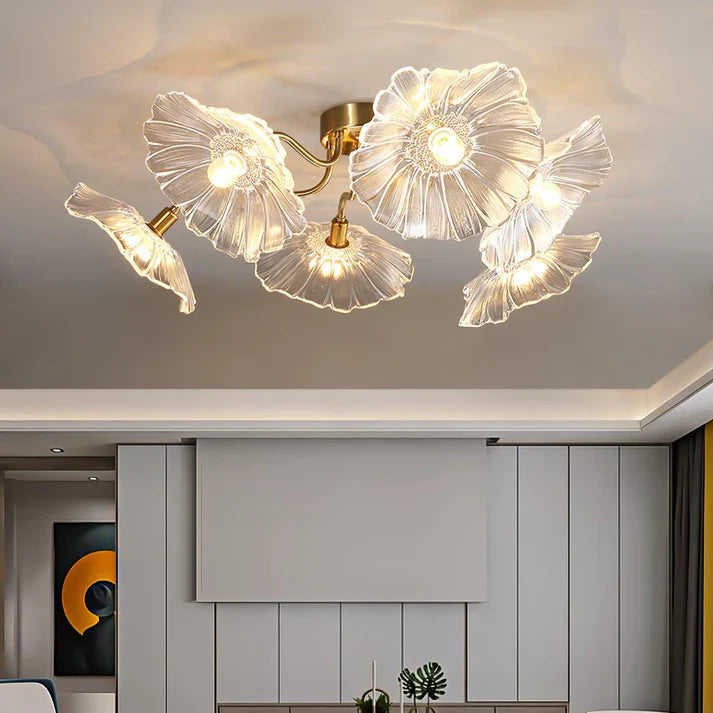
Glass Ceiling Lamp with Lotus Leaf Design — A Smart, Stylish Light for Modern Homes
A ceiling lamp inspired by a lotus leaf blends natural beauty with practical lighting. Whether you’re updating a living room, creating a calm bedroom retreat, or adding character to a hallway, a glass ceiling lamp with a lotus leaf design can be a standout piece that’s both decorative and useful. This post walks you through what makes this style appealing, how it’s built, where it works best, and practical tips for choosing and caring for one.

Why the lotus leaf design?
The lotus leaf is a simple, recognizable motif that communicates calm, balance, and organic elegance. Designers often use it because it reads well across decor styles — from minimalist and Scandinavian to transitional and modern-boho. A glass fixture using this motif usually softens the light, creating a warm, diffused glow while still making an artistic statement on the ceiling.
Design & materials: what to expect
Most glass ceiling lamps with a lotus leaf design combine a few core elements:
-
Shaped glass shade: The glass is often molded or hand-blown into a petal or leaf-like silhouette. Frosted or opal glass is common because it diffuses light gently; clear textured glass can create more sparkle.
-
Subframe or accent: Metal accents (brass, nickel, black matte) outline the leaf form or attach the glass to the ceiling mount. The finish you choose will affect the fixture’s overall vibe.
-
Diffusion and layering: Some designs use layered glass pieces to mimic overlapping lotus leaves, which gives depth and interesting shadow patterns.
-
Hardware quality: Look for sturdy mounts, good wiring, and easy-to-use mounting plates—these affect both safety and install ease.
Functional features to look for
A beautiful design is great, but functionality matters. Here are features you’ll want on your checklist:
-
Bulb compatibility: LED-ready sockets that accept standard or GU-type bulbs are the most convenient. LEDs save energy and run cooler.
-
Dimmability: If you want mood control, make sure the lamp supports dimmers (and choose dimmable LED bulbs).
-
Size and scale: Measure ceiling height and room dimensions. Low ceilings benefit from flush-mount or semi-flush designs; taller rooms can handle larger, more sculptural pieces.
-
Light output & color temperature: If the lamp uses diffusing glass, it will soften light—so check lumen output if you need task-level brightness. For living spaces, 2700K–3000K (warm white) is usually most comfortable.
-
Safety certifications: UL/ETL listings are important for electrical safety and code compliance.
Where to use it (room-by-room ideas)
This style is surprisingly versatile. Here are practical placement suggestions:
-
Living room: Use a larger lotus-leaf fixture as a central light or pair several smaller fixtures for visual interest. Combine with table lamps for layered lighting.
-
Bedroom: A soft, frosted lotus lamp creates a soothing overhead glow that’s perfect for winding down.
-
Dining area: Over a small dining table, a semi-flush lotus lamp adds an intimate, organic feel. For larger tables, consider a cluster or a longer linear fixture that references the leaf motif.
-
Entryway/hallway: A single sculptural piece gives an immediate impression of style without overwhelming the space.
-
Bathroom: If using in a bathroom, make sure the lamp’s rating is suitable for damp locations or use it in areas away from direct water exposure.
Installation & practical considerations
-
Ceiling height: For 8-foot ceilings, choose flush or semi-flush mounts. Above 9 feet, you can go more sculptural.
-
Wiring: If you’re replacing an existing fixture, most mounts will match standard junction boxes. If not comfortable with electrical work, hire a licensed electrician.
-
Weight: Glass fixtures can be heavier than basic shades. Confirm that the junction box and ceiling support can handle the fixture’s weight.
-
Cleaning access: Consider how easy it will be to remove or clean the glass pieces. Fixtures with removable shades are much easier to maintain.
Care & maintenance
Glass lotus leaf lamps are low-maintenance if you follow a few simple steps:
-
Turn power off at the breaker before cleaning or changing bulbs.
-
Dust regularly with a microfiber cloth to prevent buildup.
-
For a deeper clean, remove the glass shade (if possible) and wash with mild soap and warm water; dry completely before reinstalling.
-
Check metal finishes periodically for signs of wear; mild metal polish can restore luster on brass or nickel if needed.
-
Replace bulbs with the same wattage/type recommended by the manufacturer.
Buying tips — what to ask the seller
When shopping, ask or look for:
-
Exact dimensions and weight.
-
Type of glass (frosted, opal, clear, hand-blown).
-
Compatible bulb types and maximum wattage.
-
Dimmability info and whether a dimmer switch is required.
-
Mounting hardware included and whether the fixture is rated for damp locations (if relevant).
-
Warranty and return policy.
Final thought
A glass ceiling lamp with a lotus leaf design is more than just illumination — it’s a decorative element that sets mood, softens a space, and adds personality without shouting. Choose the right size, pair it with suitable bulbs, and give it a little routine care, and it’ll serve as a calm, elegant focal point in your home for years to come.
Would you like a short product description or social post version of this blog for your store listing or Instagram? I can tailor it to match your brand voice.
